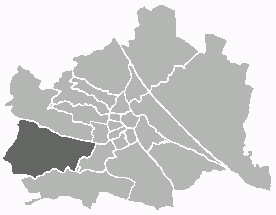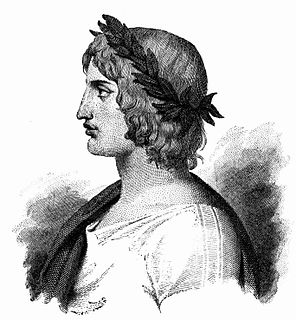
Rococo, less commonly roccoco, or "Late Baroque", is a highly ornamental and theatrical style of decoration which combines asymmetry, scrolling curves, gilding, white and pastel colors, sculpted molding, and trompe l'oeil frescoes to create the illusions of surprise, motion and drama. It first appeared in France and Italy in the 1730s and spread to Central Europe in the 1750s and 1760s. It is often described as the final expression of the Baroque movement.
Heinrich Wilhelm Schott was an Austrian botanist well known for his extensive work on aroids.

Ludwigsburg Palace, also known as the "Versailles of Swabia", is a 452-room palace complex of 18 buildings located in Ludwigsburg, Baden-Württemberg, Germany. Its total area, including the gardens, is 32 ha —the largest palatial estate in the country. The palace has four wings: the northern wing, the Alter Hauptbau, is the oldest and was used as a ducal residence; the east and west wings were used for court purposes and housing guests and courtiers; the southern wing, the Neuer Hauptbau, was built to house more court functions and was later used as a residence.

Johann Bernhard Fischer von Erlach was an Austrian architect, sculptor, and architectural historian whose Baroque architecture profoundly influenced and shaped the tastes of the Habsburg Empire. His influential book A Plan of Civil and Historical Architecture (1721) was one of the first and most popular comparative studies of world architecture. His major works include Schönbrunn Palace, Karlskirche, and the Austrian National Library in Vienna, and Schloss Klessheim, Holy Trinity Church, and the Kollegienkirche in Salzburg.
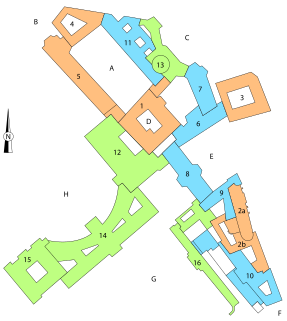
The Hofburg is the former principal imperial palace of the Habsburg dynasty rulers and today serves as the official residence and workplace of the President of Austria. It is located in the center of Vienna and was built in the 13th century and expanded several times afterwards. It also served as the imperial winter residence, as Schönbrunn Palace was the summer residence.

Charlottenburg Palace is the largest palace in Berlin, Germany. It is in the Charlottenburg district of the Charlottenburg-Wilmersdorf borough.
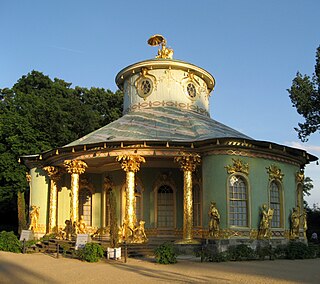
The Chinese House is a garden pavilion in Sanssouci Park in Potsdam, Germany. Frederick the Great had it built, about seven hundred metres southwest of the Sanssouci Summer Palace, to adorn his flower and vegetable garden. The garden architect was Johann Gottfried Büring, who between 1755 and 1764 designed the pavilion in the then-popular style of Chinoiserie, a mixture of ornamental rococo elements and parts of Chinese architecture.

Matthias Steinl was an Austrian painter, architect and designer, and one of the country's best known Baroque sculptors. Together with Johann Bernhard Fischer von Erlach (1656–1723) and his rival Johann Lukas von Hildebrandt (1668–1765), Steinl may be considered one of the most influential architects to introduce the High Baroque style to Austria.

Paul Strudel or Paul Strudl was an Austrian sculptor, architect, engineer, and painter, ennobled as Baron von Strudel and Vochburg.

The sculptures in the Schönbrunn Garden at Schönbrunn Palace in Vienna, Austria were created between 1773 and 1780 under the direction of Johann Wilhelm Beyer, a German artist and garden designer. The Great Parterre of Schönbrunn Garden is lined on both sides with 32 over life-size sculptures that represent mythological deities and virtues. The Neptune Fountain at the foot of the Gloriette hill is the crowning monument of the Great Parterre. Other sculptures are distributed throughout the garden and palace forecourt, including fountains and pools. Several sculptors were employed during the execution of these works, among them Johann Baptist Hagenauer.

Martin van Meytens was a Dutch-Swedish painter who painted members of the Royal Court of Austria such as Marie Antoinette, Maria Theresa of Austria, Francis I, Holy Roman Emperor, the Emperor's family and members of the local aristocracy. His painting style inspired many other painters to paint in a similar format.
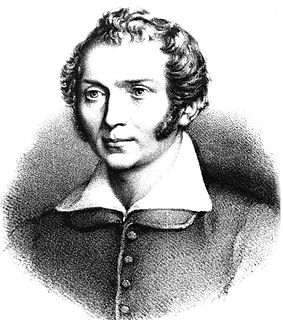
Ernst Mayer was a German sculptor in the classical style. He was a pupil of Antonio Isopi and worked for Leo von Klenze, mainly in Munich where in 1830 he became Professor of Sculpture at the Polytechnic, now the Technical University.

Franz Boos was an Austrian gardener-botanist in the Age of Enlightenment, a voyager and collector of natural history specimens for Emperor Joseph II of Austria, who reigned from 1765 to 1790.

The Winter Palace of Prince Eugene, also known as the City Palace, is a high-Baroque palace in the Innere Stadt district of Vienna, Austria. Located on a narrow street at Himmelpfortgasse 8, the palace was used as the winter residence of Prince Eugene of Savoy, who spent his summers at the Belvedere. The Winter Palace was designed and constructed by Johann Bernhard Fischer von Erlach from 1695 to 1700, and by Johann Lukas von Hildebrandt from 1702 to 1724 following his predecessor's plans.
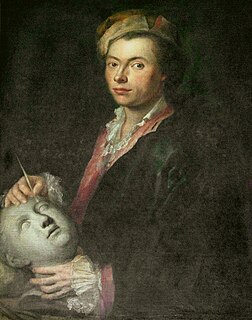
Dominik Auliczek was a sculptor and porcelain designer born in Bohemia who was employed for many years by the porcelain factory at the Nymphenburg Palace, Munich, Bavaria.

Gabriël Grupello was a Flemish Baroque sculptor who produced religious and mythological sculptures, portraits and public sculptures. He was a virtuoso sculptor who enjoyed the patronage of several European rulers.
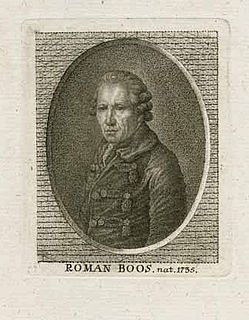
Roman Anton Boos was a German sculptor.

Ludwigsburg porcelain is porcelain made at the Ludwigsburg Porcelain Manufactory founded by Charles Eugene, Duke of Württemberg, on 5 April 1758 by decree as the Herzoglich-ächte Porcelaine-Fabrique. It operated from the grounds of the Baroque Ludwigsburg Palace. After a first two decades that were artistically, but not financially, successful, the factory went into a slow decline and was closed in 1824. Much later a series of other companies used the Ludwigsburg name, but the last production was in 2010.








